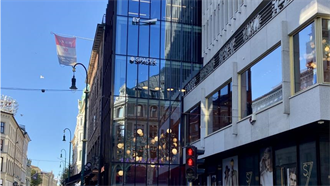Sharply changed attitudes to climate change and ESG mean energy efficiency and decarbonisation will become integral to real estate development and investment, writes Paul Danks FRICS, President of the European Regional Chapter of SIOR.
The gravity of the climate crisis became a focal point in 2021 as the real estate industry recognised its responsibility, and immense opportunity, to make a difference – with ambitious goals emerging from COP26. SIOR Europe members have been some of the leading voices in shaping a path forward, prioritising climate impact in their operations and sharing how Europe is addressing the challenge.
Attitudes have transformed from a year ago, when there was still a perception of ESG-compliant investment as an alternative choice. Now, investors actively look at sustainability credentials – with strong appetite for carbon-neutral or carbon-optimised assets and funds – and ensure that projects meet LEED or BREEAM requirements, a trend that will grow as regulations tighten.
AXI IMMO Group notes that, in Central and Western Europe, many are requesting pre-certification to show that developments will meet sustainable building requirements. Climate change and ESG will form the crux of the deal process going forward, playing a critical role in attracting investment, and maximising value and competitive advantage.
A seismic shift in priorities
Developers and long-term holders are genuinely committed to investing in making assets more sustainable, and increasingly harnessing innovation. Technology will become more integral to design and construction but also to long-term energy efficiency in finished buildings.
For instance, Turner & Townsend is working to optimise decision making and decarbonisation in the industrial and logistics space with green technologies, alternative materials, on-site power generation, waste recycling, and electric vehicle charging. Despite the disruptions of 2021, the sector still shows resilience and growth potential but is also a major contributor to carbon and waste, so fresh solutions are crucial.
Across Europe’s office sector, occupier demand for green buildings increased considerably last year. Traditional construction methods and materials have a damaging environmental footprint and, recognising the need for change, the market is embracing new certifications.
In the UK, evolving regulation such as the UK Minimum Energy Efficiency Standards only allows tenancies for commercial properties with EPC ratings above ‘F’, with the threshold set to rise from 2023. This underpins a re-focusing from acquiring new buildings to lengthening life-spans of existing ones – a trend gaining momentum in Italy, Germany and Belgium.
Embodied carbon remains a worrying industry problem. The former head of the Number 10 Policy Unit stated that 'if the cement industry were a country, it would be the third largest greenhouse gas emitter in the world'. With over two trillion square feet of new floor space due globally in the next 40 years, the potential of cradle-to-grave sustainability strategies must be championed. There has been welcome progress, as seen with TSL achieving reductions equivalent to 10,500 tonnes of CO2 and other greenhouse gasses in one project, through custom concrete mixes, innovation, and optimised earthworks, foundation, wall and roof cladding.
GLP, too, takes a 360-degree view, factoring in ESG measures and due diligence early in the investment cycle, an approach shown to lower risk while enhancing returns and operational efficiencies, and focusing on reducing embodied carbon emissions with design and materials choices. The company also collects data to measure developments’ social impact, aligning with the wider emphasis on wellbeing.
This year will see further traction with employers seeking WELL certifications and with initiatives such as the CUBE competition, which helps commercial buildings contribute to net zero by bringing landlords and occupiers together to reduce energy use through workplace behaviour change. Coming to the UK in March, CUBE has been proven elsewhere in Europe to slash energy usage and costs by up to 55% per year.
It’s encouraging to see great strides forward to tackle climate risk and accelerate ESG adoption in the built environment. What we need now is closer collaboration between everyone involved early in projects – with those leading the way demonstrating outcomes with data and knowledge sharing to encourage others to follow.
To that end, we aim to expand our community across Europe for the mutual benefit of members, clients and the wider industry, ensuring the highest quality advice, based on best practice. The popularity of green financing, and bolder government action, will also be key drivers of change in 2022.



































